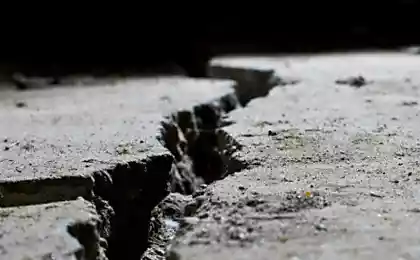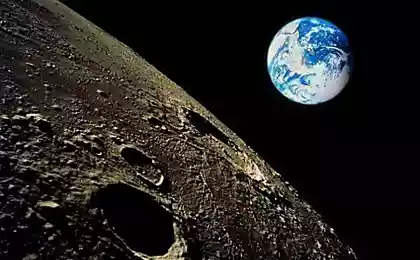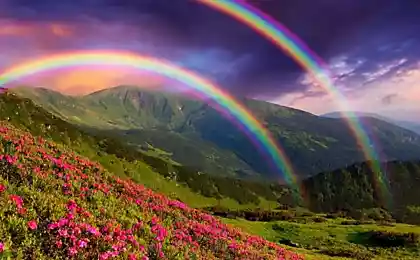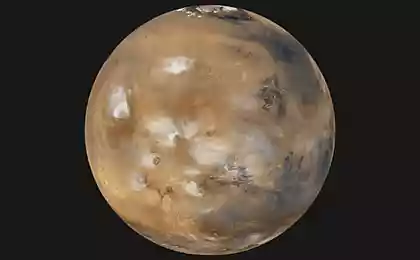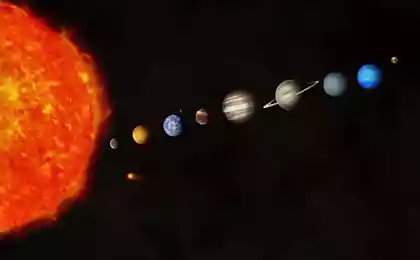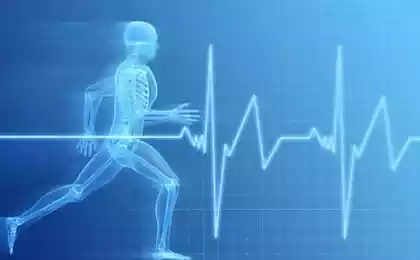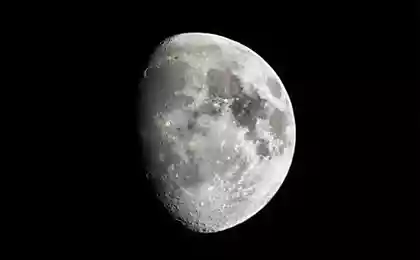880
The astronauts conducted a tour of the solar system
Dr. Marek Kukula, an astronomer at the Royal Observatory Greenwich, working with visitors, conducts a tour of the solar system, using your photos, "main attractions" of our galaxy. This collection of photographs was created from works exhibited at the competition, the best astronomical images made by a person who was held in the beginning of 2011 at the Royal Observatory.
18 photos via telegraph.co.uk translation
1. This picture is full solar disk in ultraviolet light was made on the equipment Assembly, display phenomena atmospheric Observatory of solar activity. The photograph shows the gases on the surface of the Sun and its atmosphere of 30 th March 2010. Red gases are cooler (about 60 thousand. Degrees Celsius), and the blue and green hotter (more than a million degrees). In the upper left corner of the visible solar flare.
Dr Kukula said, "space equipment, such as that which has Observatory of solar activity, allows us to" see "the light wavelength that is not given to the human eye to perceive. Well familiar solar disk looks dark in the ultraviolet, but in this picture, we see that it is surrounded by a thin veil of gas and covered with spots of bright zones of intense solar activity, each of which is the size of Earth.
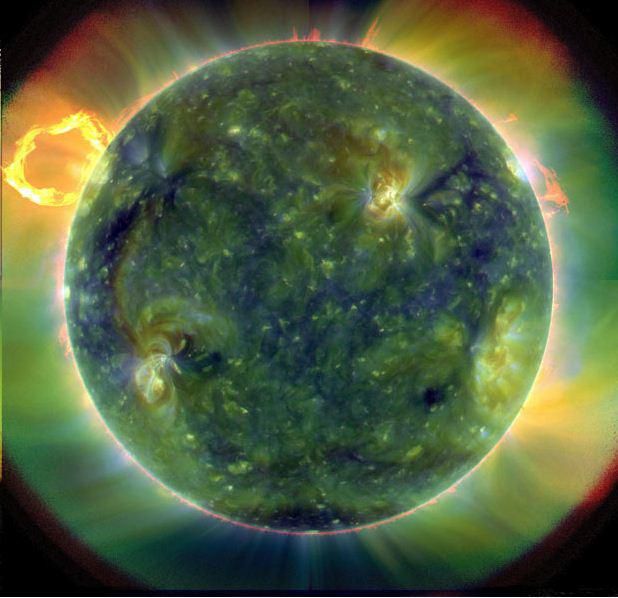
2. Sunset on Mars. Photo from the Mars rover Spirit shows the western sky at Gusev Crater at sunset. We see the bluish glow that surrounds our star. On Mars, like the glow can be seen two hours after sunset or two hours before sunrise. This phenomenon is due to the large amount of dust particles in the atmosphere, which is reflected from the surface, sunlight is scattered and remains visible for some time in the night sky. These particles give the rest of the sky in the picture reddish. Similar pictures allow us to study the atmosphere of Mars. Spirit and its partner - the rover Opportunity was launched in the summer of 2003 and the first of them reached the destination of the 3rd January 2004. Spirit's mission is to analyze the soils and rocks, as well as the search for water. The photo was taken Spirito 489 th day of his stay on Mars, 19 May 2005.
Dr Kukula said, "NASA's Mars rover Spirit gives us the opportunity to look at Mars through the eyes of the first astronauts to set foot on the red planet. The sun here seems smaller than Earth because Mars is much farther from the main star of our system. "

3. Increased photograph taken by NASA satellites, shows the crater Stickney on Phobos - the larger of the two Martian moons. Phobos has an irregular shape and size 19h21h27 km. Big Stickney crater (right) has a diameter of 10 km. Circle of Phobos' orbit around Mars is 9,400 km, which takes away the satellite is about 7 hours and 10 minutes to make a full circle.
Dr Kukula said, "Tiny Phobos all pockmarked by craters that are stamped on it by collisions with space debris. The largest crater named Stickney, a diameter of 10 kilometers, nearly one-third the size of Phobos. Face it with something a little more - and the satellite can be destroyed by such a blow. "
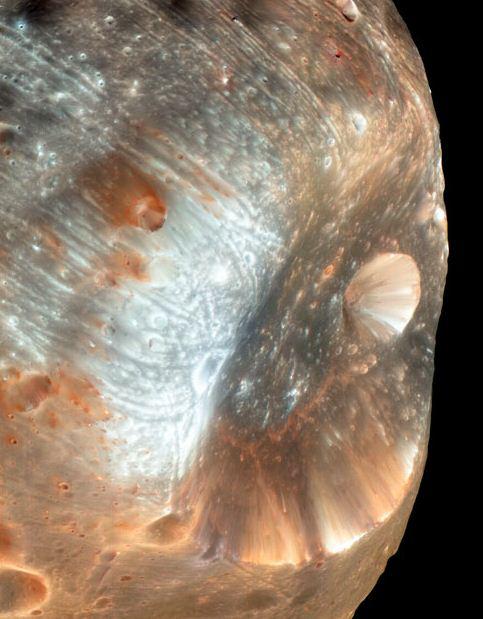
4. This is a retouched photo sand dunes on Mars, made by August 24, 2009 NASA satellite orbiting Mars. Dr Kukula explains: "At kilometer stretch of Martian desert shows that the sand dunes are cut by some strange black stripes. Just as on Earth, these figures are carved in the desert winds. Sand, sliding down the steep slopes, leaving dark streaks at the edges of the dunes, and a mini-tornadoes known as "dust devils" draw the intricate patterns on the landscape, raising the upper layers of dust and light exposing darker sand under your bottom. "
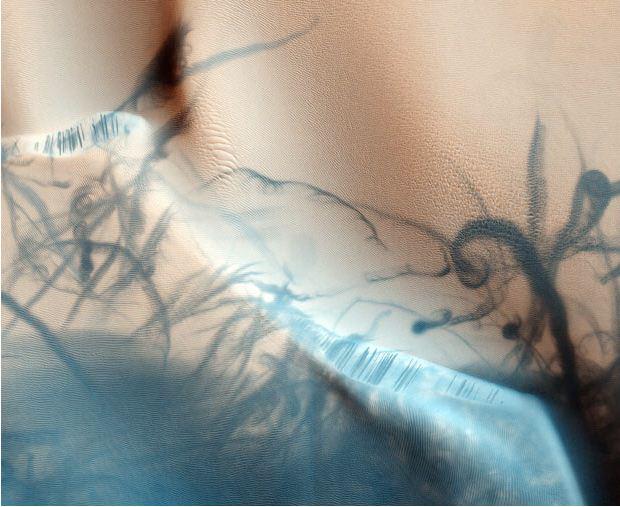
5. Another retouched picture was taken 13th September 2008 NASA's experimental camera with high resolution. In the photo we see a steep cliff at the snow cap of Mars. Orbiting satellites flew just past the cliffs in the polar regions of the Red Planet. They consist of layers of red dust and pale ice that if the annual rings of trees the earth can tell us about the changes in the Martian climate.
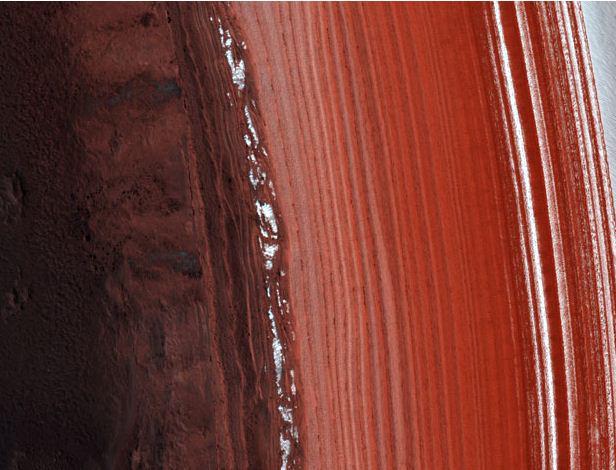
6. Photo aboard Voyager 2 shows the Great Red Spot on Jupiter in the south of its equatorial belt. Dr Kukula said, "Traveling farther from the sun, we find ourselves in a swirling cloud over the giant planet Jupiter. Incredible size ball of gas, which never touch the sun's rays - that's what Jupiter is composed, in fact, from one atmosphere. Voyager 2 The picture shows one of the most severe weather in the solar system. Great Red Spot - a storm the size of Earth, which is spewing ancient rain and snow and not even think off.
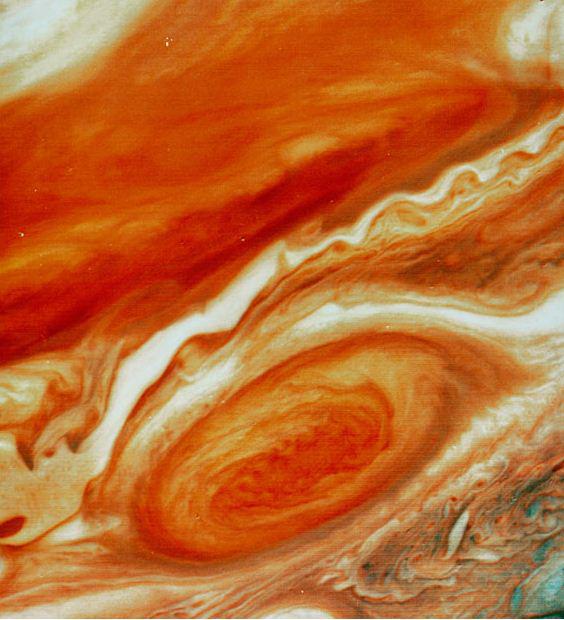
7. Infrared photography of the northern hemisphere of Saturn has been made with the spacecraft Cassini-Huygens camera with a wide focus on April 5, 2007 from a distance of approximately 1, 4 million kilometers from Saturn. In the upper left corner of the visible fragment of the rings, painted in bright blue. Dr. Kukule explains: "Cassini has on-board cameras that detect infrared radiation, distinguishing those parts of Saturn, which are not visible to the naked eye. The clouds around the planet retouched with different colors to highlight the various chemical components of the atmosphere of the planet. The blue color of Saturn's rings, of course, also is not natural - it was decided to allocate the infrared radiation that emanates from them.
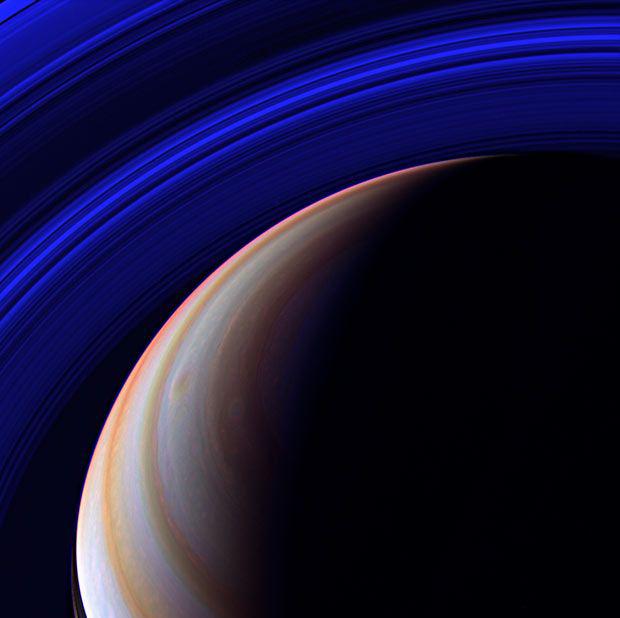
8. Another picture of Saturn's rings, Cassini-Huygens mission. These bands are made up of ice and rock formations. In the center of the picture, we see a big gap between the rings sector A (outer right) and sectors (domestic, left). Cassini was launched in 1997 to explore Saturn, its rings and its moons. This photo was taken with a narrow chamber foreshortening of 18 May 2005 from a distance of 2, 4 million kilometers from Saturn. Dr Kukula commented: "This is a picture of Saturn's rings from close range. Two large sector of the rings are composed of thin orbital circles and separated by a black stripe of empty space. The rings are made up of a billion ice blocks the size of a couple of meters. Perhaps this is the wreckage of another moon of Saturn, it exploded in a collision with some other object set of centuries ago. "

9. It is also a retouched picture of Saturn's moon Hyperion, made by the same Cassini-Huygens on 26 September 2005. For this image was combined use of infrared, green and ultraviolet filters, which are equipped with cameras of the spacecraft. Shot captured from a distance of about 62 thousand. Km of Hyperion. Dr Kukula said, "like a giant sponge shower, floating in the space, Hyperion is one of the strangest of Saturn's moons. Many of its craters are filled with some unknown substance frozen, and yet it is like a sponge, can be compressed. Therefore, many scientists believe that the satellite is in many caves and empty cavities. This strange object could be a fragment of a larger satellite, remaining after the explosion. "

10. On the next picture of the ship Cassini-Huygens Saturn and depicted one of its moons Mimas. The bands on the planet - is the shadow cast by its rings. This photo was taken from a distance of 1, 4 million kilometers from Saturn 18 January 2005. Comment doctor Kukula: "This strange perspective shows us the clouds of Saturn bluish color, jagged shadows of the rings of the planet. At the bottom of the photo we see a small moon Mimas, the amount of which is approximately equal to the size of Scotland. Baby constantly circling in its orbit above the atmosphere of Saturn. "
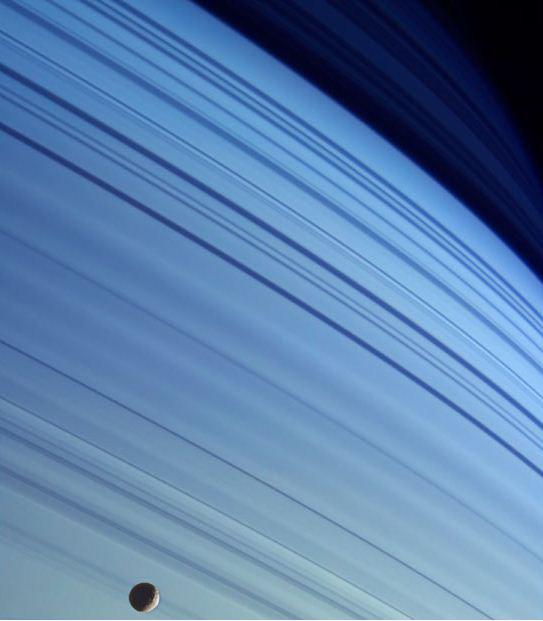
11. The surface of Saturn's moon Enceladus on a photograph taken by Cassini-Huygens at a distance of 25 700 km. Dr Kukula explains: "Cassini flew close to Enceladus, gliding over its icy surface to make it a close-up photo. The satellite covered with cracks and scratches from the powerful gravity of Saturn nearby. But the fact that the satellite can withstand such pressure gives scientists reason to believe that under a layer of ice hidden pockets of liquid water. Who knows, maybe these underground reservoirs are able to ensure the existence of primitive forms of life. "
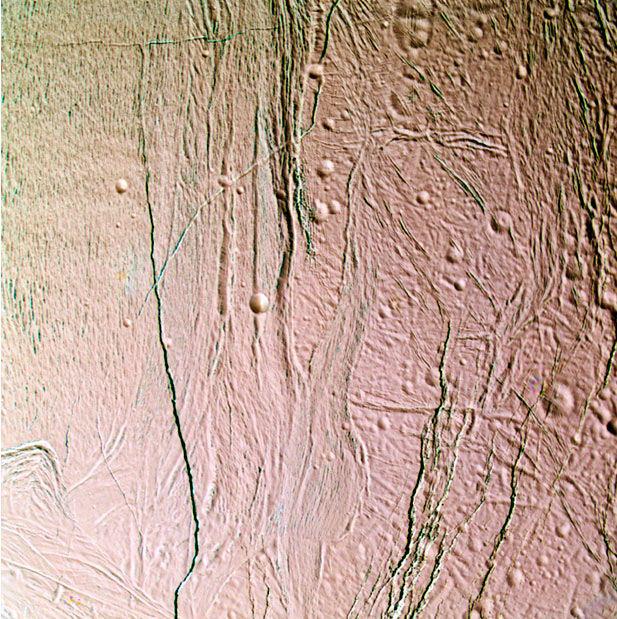
12. Dion and shadows of Saturn's rings on another photos Cassini-Huygens mission. Dione diameter is approximately 1.123 km and extends its orbit about 377 thousand. Km of the surface of Saturn. In this image, the shadow of the rings hung over the satellite, passing through its center. Thanks to the tilt of Saturn to the Sun at this point, ring shadows stretched across the sky, rising above the top of the picture. Depending on the density of the rings differ in brightness shade darker shades. This photo was taken on September 22, 2005, when Cassini was flying at about 803 thousand. Km of Dione. Dr Kukula said, "The narrow line in the middle of the image - is a land of powerful ring system. Despite the fact that they are scattered more than 100 thousand. Km around Saturn, the rings themselves negligibly thin - only tens of meters from end to end. Satellite Dion looks tiny against the backdrop of Saturn's huge. "
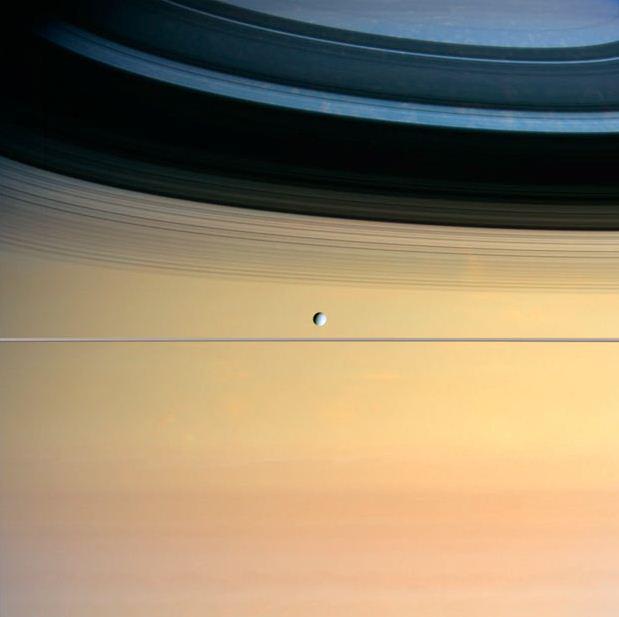
13. retouched picture Satrurna satellite Iapetus was made ship Cassini-Huygens at a distance of 73 thousand. Km of 10 September 2007. Dr Kukula explains: "Iapetus - one of the most unusual moons of the solar system. He is half black and half white. The party, which he rotated to us in the picture, covered with intact ice, and its other hemisphere blackened some black substance. At the bottom of the picture we see a crater the size of Britain. "
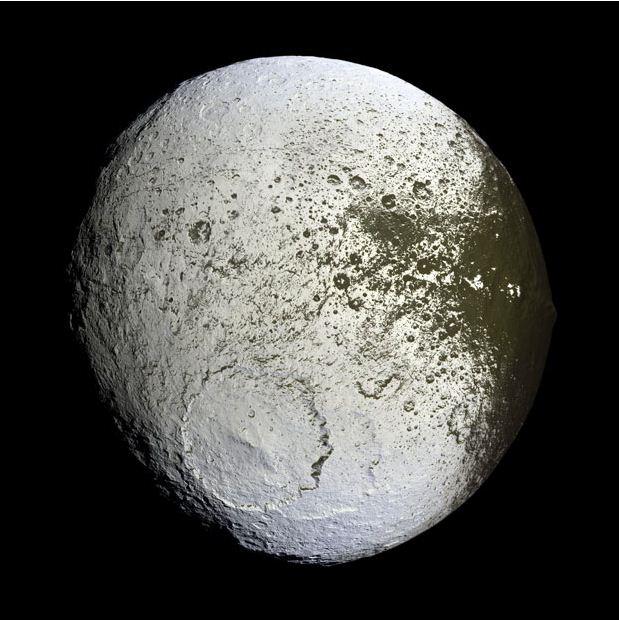
14. In this photo taken on 18 January 2006 with the Cassini-Huygens mission, we see Enceladus, hovering over Saturn's rings. Comment doctor Kukula: "Another view from the edge on the rings of Saturn. This time on a similar background can be seen the pale moon Enceladus. From the bottom of the picture incident solar rays illuminating the back of the rings and the icy surface of Enceladus - one of the white celestial bodies in the solar system. For satellite dusk gathering over the clouds of Saturn and the rings cast long shadows. "

15. And this is the biggest Saturn's moon Titan, filmed on December 26, 2005, Cassini-Huygens mission. Dr Kukula said, "surpassing the size of the planet Mercury, the giant moon Titan - a truly wonderful world. A thick layer of orange smog obscures the surface of Titan, forcing scientists for decades scratching their heads over what's going on underneath. The Cassini spacecraft is equipped with special cameras, allows you to look through the fog, and the European probe Huygens, who was parachuted to the surface of Titan through the bright clouds. These two devices showed us the landscape consisting of mountains and sand dunes interspersed with oily hydrocarbon seas - completely "prishelchesky" landscape, though vaguely and reminiscent of the Earth. "

16. The explosion on the surface of a comet "Tempel 1" for a minute before it blew to smithereens the spacecraft Deep Impact "Deep Impact." Dr Kukula explains: "In 2005," Deep Impact "NASA met the comet" Tempel 1 "and sent it to the shock tube to blow the seven-kilometer" alloy "of ice and stone, flying at a speed of several kilometers per second. The result is a spectacular zvryv, rising from the surface of the comet cloud of dust and vapor. From time to time the comet fell to Earth, and one of those blows might have killed the dinosaurs. So the mission of "Deep Impact" can be regarded as a place of earthlings comets. But seriously speaking, the main purpose of the probe is to determine the composition and structure of comets. "
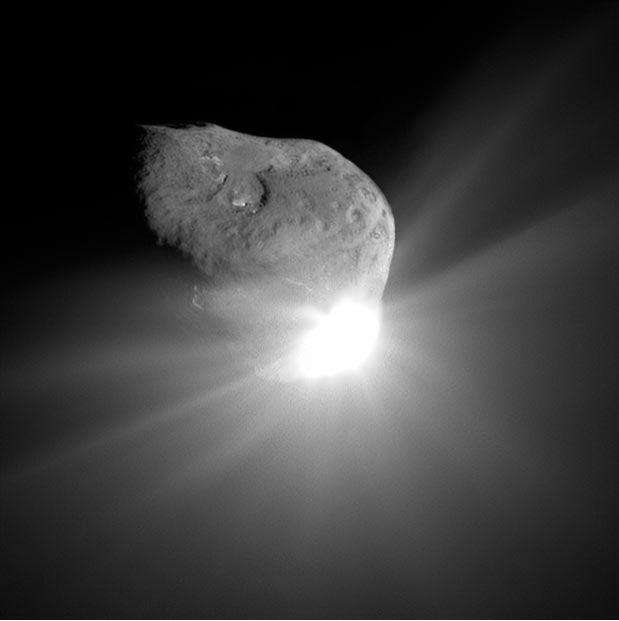
17. On approaching the house is visible gibbous Moon, translucent over the horizon of the Earth through the atmosphere. This picture was taken of the 3rd November 2007 the 16th crew of the International Space Station, which should be in its orbit at a distance of approximately 350 km above the Earth's surface. Dr Kukula said, "ISS - is our permanent manned space fotopost. But compared with the distance to the moon (400 thous. Km), the ISS is hardly detached from the surface of the Earth. And for the entire 42-year history of visits human space - the most distant point where we could get. "
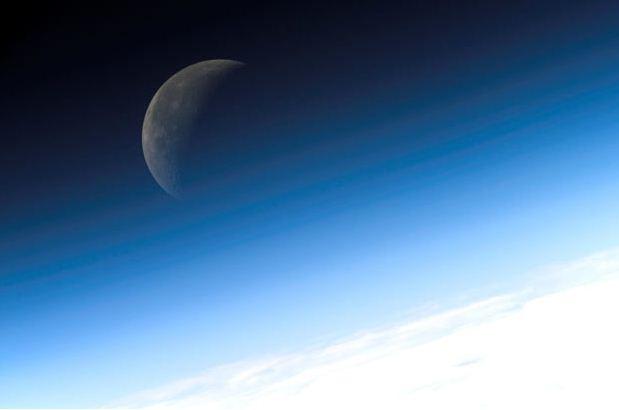
18. Dr Kukula said, "I am extremely proud that I had the opportunity to live in an era of great discoveries, when our knowledge of the universe multiplied so quickly. Looking into the depths of space, we learn more and about the Earth, its origin and the special conditions that allowed life to flourish on this planet. I hope this will teach us to appreciate our fragile planet and realize that we are responsible to future generations for its preservation. "
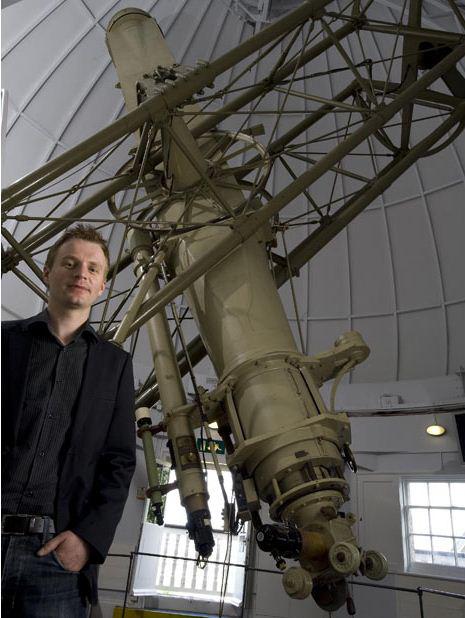
Source:
18 photos via telegraph.co.uk translation
1. This picture is full solar disk in ultraviolet light was made on the equipment Assembly, display phenomena atmospheric Observatory of solar activity. The photograph shows the gases on the surface of the Sun and its atmosphere of 30 th March 2010. Red gases are cooler (about 60 thousand. Degrees Celsius), and the blue and green hotter (more than a million degrees). In the upper left corner of the visible solar flare.
Dr Kukula said, "space equipment, such as that which has Observatory of solar activity, allows us to" see "the light wavelength that is not given to the human eye to perceive. Well familiar solar disk looks dark in the ultraviolet, but in this picture, we see that it is surrounded by a thin veil of gas and covered with spots of bright zones of intense solar activity, each of which is the size of Earth.

2. Sunset on Mars. Photo from the Mars rover Spirit shows the western sky at Gusev Crater at sunset. We see the bluish glow that surrounds our star. On Mars, like the glow can be seen two hours after sunset or two hours before sunrise. This phenomenon is due to the large amount of dust particles in the atmosphere, which is reflected from the surface, sunlight is scattered and remains visible for some time in the night sky. These particles give the rest of the sky in the picture reddish. Similar pictures allow us to study the atmosphere of Mars. Spirit and its partner - the rover Opportunity was launched in the summer of 2003 and the first of them reached the destination of the 3rd January 2004. Spirit's mission is to analyze the soils and rocks, as well as the search for water. The photo was taken Spirito 489 th day of his stay on Mars, 19 May 2005.
Dr Kukula said, "NASA's Mars rover Spirit gives us the opportunity to look at Mars through the eyes of the first astronauts to set foot on the red planet. The sun here seems smaller than Earth because Mars is much farther from the main star of our system. "

3. Increased photograph taken by NASA satellites, shows the crater Stickney on Phobos - the larger of the two Martian moons. Phobos has an irregular shape and size 19h21h27 km. Big Stickney crater (right) has a diameter of 10 km. Circle of Phobos' orbit around Mars is 9,400 km, which takes away the satellite is about 7 hours and 10 minutes to make a full circle.
Dr Kukula said, "Tiny Phobos all pockmarked by craters that are stamped on it by collisions with space debris. The largest crater named Stickney, a diameter of 10 kilometers, nearly one-third the size of Phobos. Face it with something a little more - and the satellite can be destroyed by such a blow. "

4. This is a retouched photo sand dunes on Mars, made by August 24, 2009 NASA satellite orbiting Mars. Dr Kukula explains: "At kilometer stretch of Martian desert shows that the sand dunes are cut by some strange black stripes. Just as on Earth, these figures are carved in the desert winds. Sand, sliding down the steep slopes, leaving dark streaks at the edges of the dunes, and a mini-tornadoes known as "dust devils" draw the intricate patterns on the landscape, raising the upper layers of dust and light exposing darker sand under your bottom. "

5. Another retouched picture was taken 13th September 2008 NASA's experimental camera with high resolution. In the photo we see a steep cliff at the snow cap of Mars. Orbiting satellites flew just past the cliffs in the polar regions of the Red Planet. They consist of layers of red dust and pale ice that if the annual rings of trees the earth can tell us about the changes in the Martian climate.

6. Photo aboard Voyager 2 shows the Great Red Spot on Jupiter in the south of its equatorial belt. Dr Kukula said, "Traveling farther from the sun, we find ourselves in a swirling cloud over the giant planet Jupiter. Incredible size ball of gas, which never touch the sun's rays - that's what Jupiter is composed, in fact, from one atmosphere. Voyager 2 The picture shows one of the most severe weather in the solar system. Great Red Spot - a storm the size of Earth, which is spewing ancient rain and snow and not even think off.

7. Infrared photography of the northern hemisphere of Saturn has been made with the spacecraft Cassini-Huygens camera with a wide focus on April 5, 2007 from a distance of approximately 1, 4 million kilometers from Saturn. In the upper left corner of the visible fragment of the rings, painted in bright blue. Dr. Kukule explains: "Cassini has on-board cameras that detect infrared radiation, distinguishing those parts of Saturn, which are not visible to the naked eye. The clouds around the planet retouched with different colors to highlight the various chemical components of the atmosphere of the planet. The blue color of Saturn's rings, of course, also is not natural - it was decided to allocate the infrared radiation that emanates from them.

8. Another picture of Saturn's rings, Cassini-Huygens mission. These bands are made up of ice and rock formations. In the center of the picture, we see a big gap between the rings sector A (outer right) and sectors (domestic, left). Cassini was launched in 1997 to explore Saturn, its rings and its moons. This photo was taken with a narrow chamber foreshortening of 18 May 2005 from a distance of 2, 4 million kilometers from Saturn. Dr Kukula commented: "This is a picture of Saturn's rings from close range. Two large sector of the rings are composed of thin orbital circles and separated by a black stripe of empty space. The rings are made up of a billion ice blocks the size of a couple of meters. Perhaps this is the wreckage of another moon of Saturn, it exploded in a collision with some other object set of centuries ago. "

9. It is also a retouched picture of Saturn's moon Hyperion, made by the same Cassini-Huygens on 26 September 2005. For this image was combined use of infrared, green and ultraviolet filters, which are equipped with cameras of the spacecraft. Shot captured from a distance of about 62 thousand. Km of Hyperion. Dr Kukula said, "like a giant sponge shower, floating in the space, Hyperion is one of the strangest of Saturn's moons. Many of its craters are filled with some unknown substance frozen, and yet it is like a sponge, can be compressed. Therefore, many scientists believe that the satellite is in many caves and empty cavities. This strange object could be a fragment of a larger satellite, remaining after the explosion. "

10. On the next picture of the ship Cassini-Huygens Saturn and depicted one of its moons Mimas. The bands on the planet - is the shadow cast by its rings. This photo was taken from a distance of 1, 4 million kilometers from Saturn 18 January 2005. Comment doctor Kukula: "This strange perspective shows us the clouds of Saturn bluish color, jagged shadows of the rings of the planet. At the bottom of the photo we see a small moon Mimas, the amount of which is approximately equal to the size of Scotland. Baby constantly circling in its orbit above the atmosphere of Saturn. "

11. The surface of Saturn's moon Enceladus on a photograph taken by Cassini-Huygens at a distance of 25 700 km. Dr Kukula explains: "Cassini flew close to Enceladus, gliding over its icy surface to make it a close-up photo. The satellite covered with cracks and scratches from the powerful gravity of Saturn nearby. But the fact that the satellite can withstand such pressure gives scientists reason to believe that under a layer of ice hidden pockets of liquid water. Who knows, maybe these underground reservoirs are able to ensure the existence of primitive forms of life. "

12. Dion and shadows of Saturn's rings on another photos Cassini-Huygens mission. Dione diameter is approximately 1.123 km and extends its orbit about 377 thousand. Km of the surface of Saturn. In this image, the shadow of the rings hung over the satellite, passing through its center. Thanks to the tilt of Saturn to the Sun at this point, ring shadows stretched across the sky, rising above the top of the picture. Depending on the density of the rings differ in brightness shade darker shades. This photo was taken on September 22, 2005, when Cassini was flying at about 803 thousand. Km of Dione. Dr Kukula said, "The narrow line in the middle of the image - is a land of powerful ring system. Despite the fact that they are scattered more than 100 thousand. Km around Saturn, the rings themselves negligibly thin - only tens of meters from end to end. Satellite Dion looks tiny against the backdrop of Saturn's huge. "

13. retouched picture Satrurna satellite Iapetus was made ship Cassini-Huygens at a distance of 73 thousand. Km of 10 September 2007. Dr Kukula explains: "Iapetus - one of the most unusual moons of the solar system. He is half black and half white. The party, which he rotated to us in the picture, covered with intact ice, and its other hemisphere blackened some black substance. At the bottom of the picture we see a crater the size of Britain. "

14. In this photo taken on 18 January 2006 with the Cassini-Huygens mission, we see Enceladus, hovering over Saturn's rings. Comment doctor Kukula: "Another view from the edge on the rings of Saturn. This time on a similar background can be seen the pale moon Enceladus. From the bottom of the picture incident solar rays illuminating the back of the rings and the icy surface of Enceladus - one of the white celestial bodies in the solar system. For satellite dusk gathering over the clouds of Saturn and the rings cast long shadows. "

15. And this is the biggest Saturn's moon Titan, filmed on December 26, 2005, Cassini-Huygens mission. Dr Kukula said, "surpassing the size of the planet Mercury, the giant moon Titan - a truly wonderful world. A thick layer of orange smog obscures the surface of Titan, forcing scientists for decades scratching their heads over what's going on underneath. The Cassini spacecraft is equipped with special cameras, allows you to look through the fog, and the European probe Huygens, who was parachuted to the surface of Titan through the bright clouds. These two devices showed us the landscape consisting of mountains and sand dunes interspersed with oily hydrocarbon seas - completely "prishelchesky" landscape, though vaguely and reminiscent of the Earth. "

16. The explosion on the surface of a comet "Tempel 1" for a minute before it blew to smithereens the spacecraft Deep Impact "Deep Impact." Dr Kukula explains: "In 2005," Deep Impact "NASA met the comet" Tempel 1 "and sent it to the shock tube to blow the seven-kilometer" alloy "of ice and stone, flying at a speed of several kilometers per second. The result is a spectacular zvryv, rising from the surface of the comet cloud of dust and vapor. From time to time the comet fell to Earth, and one of those blows might have killed the dinosaurs. So the mission of "Deep Impact" can be regarded as a place of earthlings comets. But seriously speaking, the main purpose of the probe is to determine the composition and structure of comets. "

17. On approaching the house is visible gibbous Moon, translucent over the horizon of the Earth through the atmosphere. This picture was taken of the 3rd November 2007 the 16th crew of the International Space Station, which should be in its orbit at a distance of approximately 350 km above the Earth's surface. Dr Kukula said, "ISS - is our permanent manned space fotopost. But compared with the distance to the moon (400 thous. Km), the ISS is hardly detached from the surface of the Earth. And for the entire 42-year history of visits human space - the most distant point where we could get. "

18. Dr Kukula said, "I am extremely proud that I had the opportunity to live in an era of great discoveries, when our knowledge of the universe multiplied so quickly. Looking into the depths of space, we learn more and about the Earth, its origin and the special conditions that allowed life to flourish on this planet. I hope this will teach us to appreciate our fragile planet and realize that we are responsible to future generations for its preservation. "

Source:
In Moscow, 38-year-old Muscovite was the victim of a new machine with spetssignalami.
Soviet cartoons and movies

